Form 1 Attachment 1 Awardee Survey
Evaluation of the NIH Academic Research Enhancement Award (NIH/OD)
Attach 1 Awardee Survey
Web Survey Awardees
OMB: 0925-0710
NIH OFFICE OF THE DIRECTOR (OD) |
Attachment 1 |
Awardee Survey with Web Screenshots |
|
NATIONAL INSTITUTES OF HEALTH
ACADEMIC RESEARCH ENHANCEMENT AWARD (AREA)
AWARDEE SURVEY
Welcome.
The National Institutes of Health (NIH) has contracted with Westat, a social science research firm located in Rockville, Maryland, to conduct a survey about the experiences of researchers—like yourself—who received Academic Research Enhancement Awards (AREA). Your participation will provide valuable information that will assist the NIH in improving the AREA program.
Participation in the survey is voluntary and your responses will remain private under the Privacy Act. Your individual responses to the survey will not be shared with any units of NIH and all analyses will be de-identified. No information or opinions you provide will impact current or future grant applications you may make to NIH.
We anticipate the survey will take less than 30 minutes to complete.
If you have any questions or comments, please contact Westat at NIHAREASurvey@westat.com.
By clicking on “Begin Survey” on the next page, you will be agreeing to participate in this survey and will be advanced to the survey instrument.
-
Next
PLEASE CAREFULLY READ THE TEXT BELOW.
OMB#0925-xxxx
Exp. xx/xxxx
Collection of this information is authorized by The Public Health Service Act, Section 411 (42 USC 285a). Rights of study participants are protected by The Privacy Act of 1974. Participation is voluntary, and there are no penalties for not participating or withdrawing from the study at any time. Refusal to participate will not affect your benefits in any way. The information collected in this study will be kept private to the extent provided by law. Names and other identifiers will not appear in any report of the study. Information provided will be combined for all study participants and reported as summaries. You are being contacted to complete this instrument so that we can evaluate the Academic Research Enhancement Award (AREA) grant mechanism.
Public reporting burden for this collection of information is estimated to average 30 minutes per response, including the time for reviewing instructions, searching existing data sources, gathering and maintaining the data needed, and completing and reviewing the collection of information. An agency may not conduct or sponsor, and a person is not required to respond to, a collection of information unless it displays a currently valid OMB control number. Send comments regarding this burden estimate or any other aspect of this collection of information, including suggestions for reducing this burden to: NIH, Project Clearance Branch, 6705 Rockledge Drive, MSC 7974, Bethesda, MD 20892-7974, ATTN: PRA. Do not return the completed form to this address.
-
Begin Survey
APPLICATION PROCESS
The first part of the survey addresses your experience of the application process.
Through which of the following mechanisms did you first learn of the NIH’s AREA grant program?
-
A colleague or administrator at my institution
A colleague or mentor at another institution
A conversation with NIH staff
A presentation by NIH staff
NIH’s website
A funding opportunities database
Other (please specify) ___________________________________________________________________
Below are reasons why researchers may apply for AREA funding. Please indicate how important each reason was in your decision to apply to the AREA program.
|
Extremely important |
Very important |
Somewhat important |
Not at all important |
a. Funding from my institution was unavailable or insufficient for my research. |
|
|
|
|
b. My institution encourages me to seek external research funding. |
|
|
|
|
c. NIH AREA funding allows me to reduce my teaching or service commitments. |
|
|
|
|
d. NIH AREA funds provide me with salary support beyond the academic year. |
|
|
|
|
e. I am expected to supplement my university salary with research funds. |
|
|
|
|
f. My institution’s commitment to the project depends on receiving external funding. |
|
|
|
|
g. NIH AREA funding provides external validation for the merit of the project. |
|
|
|
|
h. NIH AREA funding facilitates the training of undergraduates. |
|
|
|
|
i. NIH AREA funding facilitates the training of graduate and health professional students. |
|
|
|
|
j. NIH AREA funding facilitates collaboration within my institution. |
|
|
|
|
AREA PROJECT
This section addresses dissemination of findings from your most recent AREA project.
Box A: Publications. Please review the publications in this list and indicate which were funded by your most recently completed R15/ AREA grant.
Number |
Publication |
AREA-funded? |
Not my publication |
1. |
Pre-populated |
Y N |
|
2. |
|
Y N |
|
3. |
|
Y N |
|
4. |
|
Y N |
|
5. |
|
Y N |
|
6. |
|
Y N |
|
7. |
|
Y N |
|
Box B: Additional AREA publications not listed above. In the space below, please add any AREA-funded publications and patents that do not appear in Box A above.
|
|
|
|
|
|
|
|
|
|
|
|
|
|
|
|
|
|
|
|
|
|
|
|
|
|
|
|
|
|
To what extent did AREA funding support your efforts to…?
|
A great extent |
A moderate extent |
A small extent |
Not at all |
a. …conduct high quality research? |
|
|
|
|
b. ….increase your research productivity? |
|
|
|
|
c. ….obtain additional – or subsequent – funding to support your research? |
|
|
|
|
d. ….collaborate with your peers at your institution? |
|
|
|
|
e. ….enhance the training of undergraduates in research? |
|
|
|
|
f. …enhance the training of graduate (MA, MS, PhD) students in research? |
|
|
|
|
g. …enhance the training of health professional (MD, DVM, PharmD) students in research? |
|
|
|
|
Did you conduct, or are you conducting, research on the same, or a similar, topic as your AREA project subsequent to your AREA award?
|
Yes |
|
No |
In the five (5) years following the start date of your AREA project, about how much funding did you receive to continue the line of research represented by your AREA project? (include personnel support but not tuition waivers)
Your best estimate is fine.
a. Funding from sources within my institution: $________ million
thousand
none
b. Funding from sources outside my institution: $ ________ million
thousand
none [SKIP to Q9]
[If no funding was committed to the AREA’s line of research, SKIP to Question 9.]
In the five (5) years following the start date of your AREA project, did you receive funding from the following external sources for the line of research represented by your AREA application?
a. Federal government programs (other than AREA)
-
Yes, specify agency and program name: _____________________________
No
Don’t know
b. State or local government programs
-
Yes, specify agency and program name: _____________________________
No
Don’t know
c. Private foundations or organizations
-
Yes, specify organization name: ___________________________________
No
Don’t know
Are you still active as a researcher?
|
Yes |
|
No [SKIP to Q13] |
Will you conduct research similar to your AREA project in the future?
|
Yes |
|
No |
How likely is it that you will apply again to the AREA program?
-
Very likely [SKIP TO Q13]
Somewhat likely [SKIP TO Q13]
Somewhat unlikely
Very unlikely
Don’t know
Why are you unlikely to seek AREA funding in the future?
Select all that apply:
|
My current institution is not AREA-eligible. |
|
|
I am no longer conducting research that is AREA-eligible. |
|
|
I will be leaving an AREA-eligible institution soon. |
|
|
I am—or will be—retiring shortly. |
|
|
Other funding sources are a better fit for my research. |
|
|
The application and review process was too burdensome. |
|
|
My teaching and service responsibilities do not allow enough time for research. |
|
|
My other faculty responsibilities do not allow enough time for mentorship of individual students. |
|
|
Students at my institution are not appropriate for AREA-program participation. |
|
|
Other (specify): |
|
Student involvement
Since AREA-funded projects involve students in the research process, the next questions ask about the students who participated in your AREA project.
What was the total number of each of the following kinds of students who worked in your lab during the time you conducted your most recent AREA project? (Please estimate to the best of your ability.)
TYPE OF STUDENT |
NUMBER |
DON’T REMEMBER |
High School students |
|
|
Undergraduate students |
|
|
Graduate students (MA, MS, PhD) |
|
|
Health professional (MD, PharmD, DDS, etc.) students |
|
|
Of the totals above, how many of each of the following types of students worked at all on your AREA project?
TYPE OF STUDENT |
NUMBER |
DON’T REMEMBER |
High School students |
|
|
Undergraduate students |
|
|
Graduate students (MA, MS, PhD) |
|
|
Health professional (MD, PharmD, DDS, etc.) students |
|
|
How many of each of the following types of students disseminated findings via publications, presentations or posters related to your AREA project?
TYPE OF STUDENT |
NUMBER |
DON’T REMEMBER |
High School students |
|
|
Undergraduate students |
|
|
Graduate students (MA, MS, PhD) |
|
|
Health professional (MD, PharmD, DDS, etc.) students |
|
|
Undergraduate Student Involvement
Did any undergraduate students working on your AREA project…
…contribute ideas to the project design or experimental design?
-
Yes
No
…develop materials or resources needed to conduct the project?
-
Yes
No
…perform experiments, data collection, or data analysis?
-
Yes
No
…plan next steps (for example: decided relevant experiments or data analyses) to address research questions?
-
Yes
No
Please describe any other ways that undergraduate students were involved in your AREA project:
|
Of the undergraduate students who worked on your AREA project, how many…
…pursued graduate education related to the same general field as your AREA project?
Number: Don’t remember:
…pursued graduate education in a DIFFERENT scientific field?
Number: Don’t remember:
…pursued education as a health professional (MD, PharmD, DDS)?
Number: Don’t remember:
…sought employment in a biomedical or behavioral field immediately after graduation?
Number: Don’t remember:
…sought employment or graduate/professional education in a scientific field other than biomedical or behavioral science?
Number: Don’t remember:
Please specify any other research, training, or employment outcomes for your undergraduate students below:
|
Graduate or Professional Student Involvement
Did any graduate (MA, MS, PhD) and health professional (MD, PharmD, DDS, etc.) students counted as working on your AREA project…
…contribute ideas to the project design or experimental design?
-
Yes
No
…develop materials or resources needed to conduct the project?
-
Yes
No
…perform experiments, data collection, or data analysis?
-
Yes
No
…plan next steps (for example: decided relevant experiments or data analyses) to address research questions?
-
Yes
No
If graduate and health professional students were involved in your AREA project in other ways, please tell us:
|
After graduation, how many of the graduate and health professional students who worked on your AREA project…
…pursued research in a biomedical or behavioral field?
Number: Don’t remember:
…attained employment as a clinician?
Number: Don’t remember:
…attained employment in academia or in research?
Number: Don’t remember:
…attained employment outside of the biomedical or behavioral sciences?
Number: Don’t remember:
Please specify any other research, training, or employment outcomes for your graduate and health professional students below:
|
COLLABORATION
Next we turn to the possible impact of your AREA grant on your collaboration.
In conducting your most recent AREA project, did you collaborate with…
…researchers at your institution? Y N
…researchers at another institution? Y N
How did the AREA project affect your collaboration with colleagues…
|
Increased collaboration |
No effect |
Decreased collaboration |
|
|
|
|
|
|
|
|
Did you seek collaborator[s] for specialized content knowledge or analytical techniques…
…at your institution? Y N
…at another institution? Y N
Did you seek collaborator[s] for expertise in research design…
…at your institution? Y N
…at another institution? Y N
Did you seek collaborator[s] for access to data or a particular research population…
…at your institution? Y N
…at another institution? Y N
Did you seek collaborator[s] for access to resources…
…at your institution? Y N
…at another institution? Y N
Any there any other reasons you sought collaborators?
|
Did the collaboration with researchers at your institution extend to subsequent projects?
|
Yes |
|
No |
Did the collaboration with researchers at another institution extend to subsequent projects?
|
Yes |
|
No |
Thank you for completing the AREA survey.
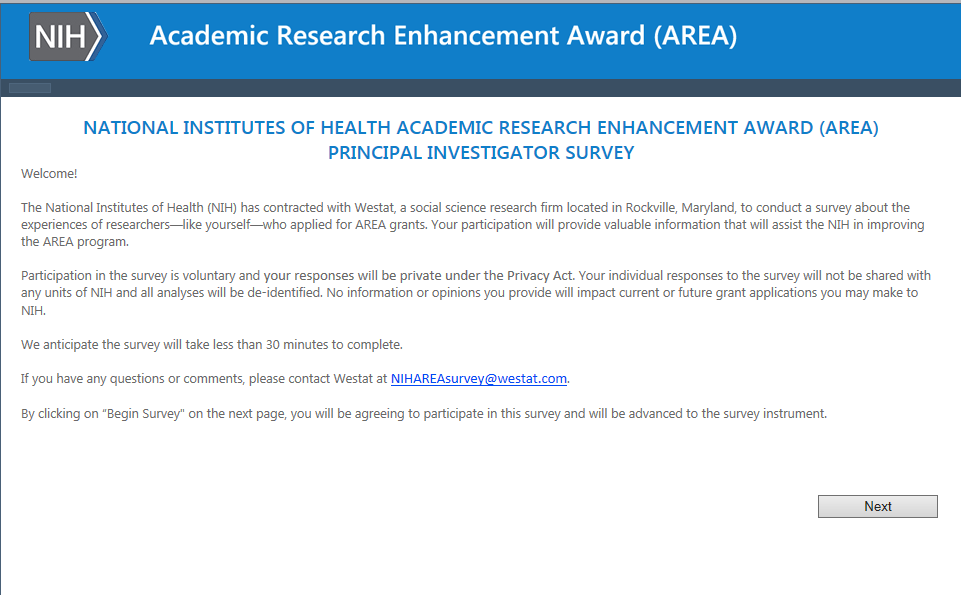

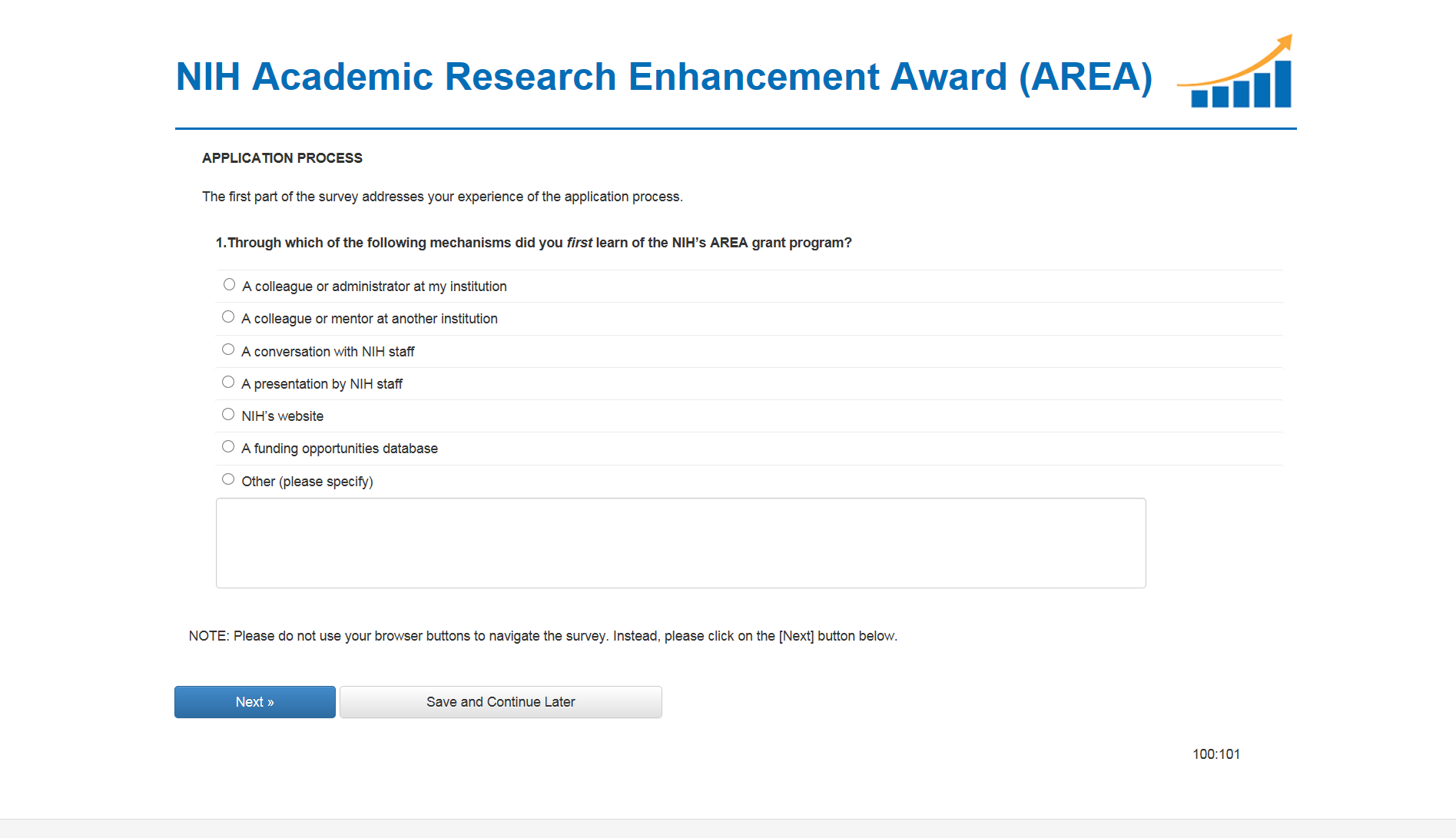
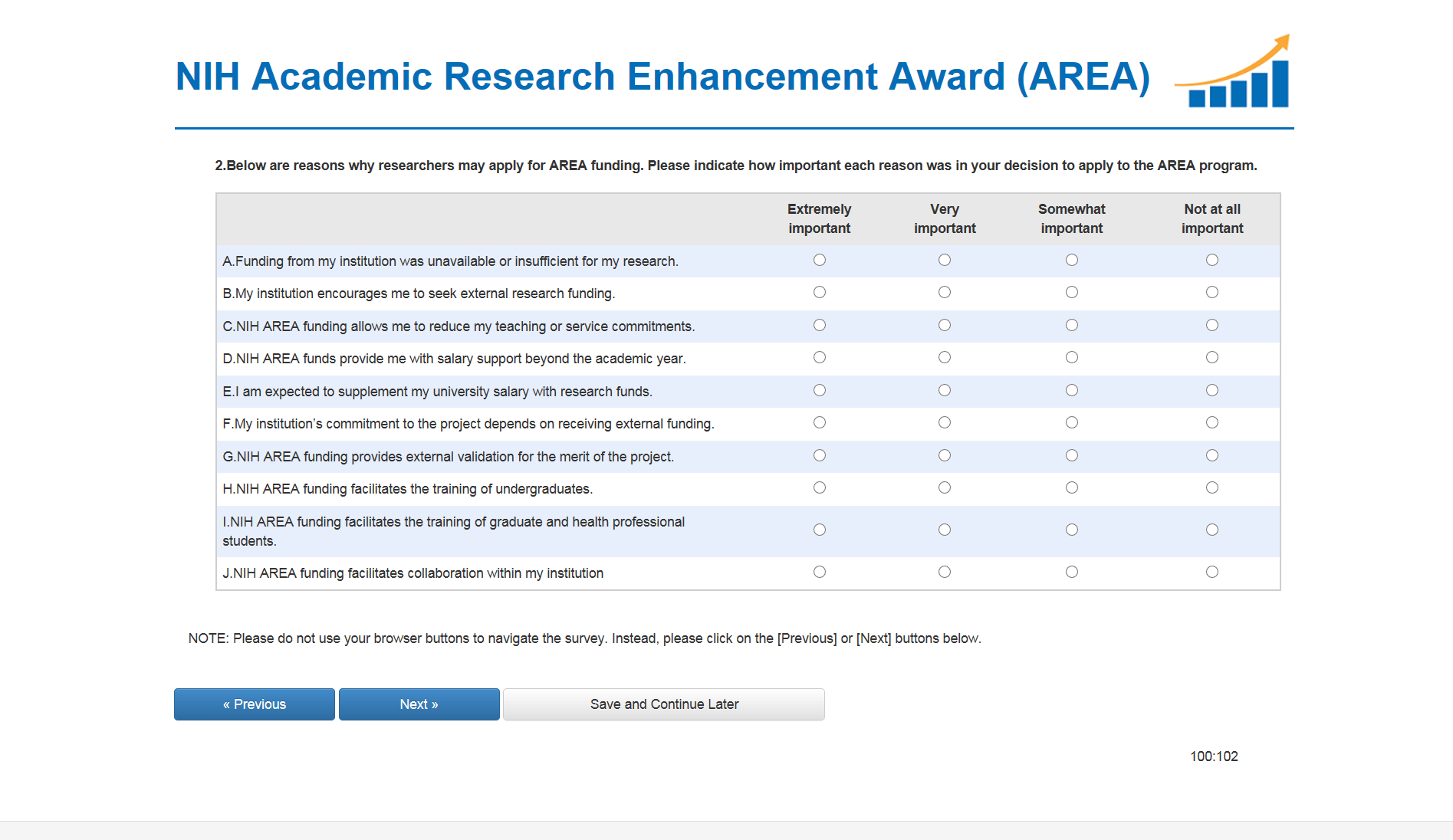
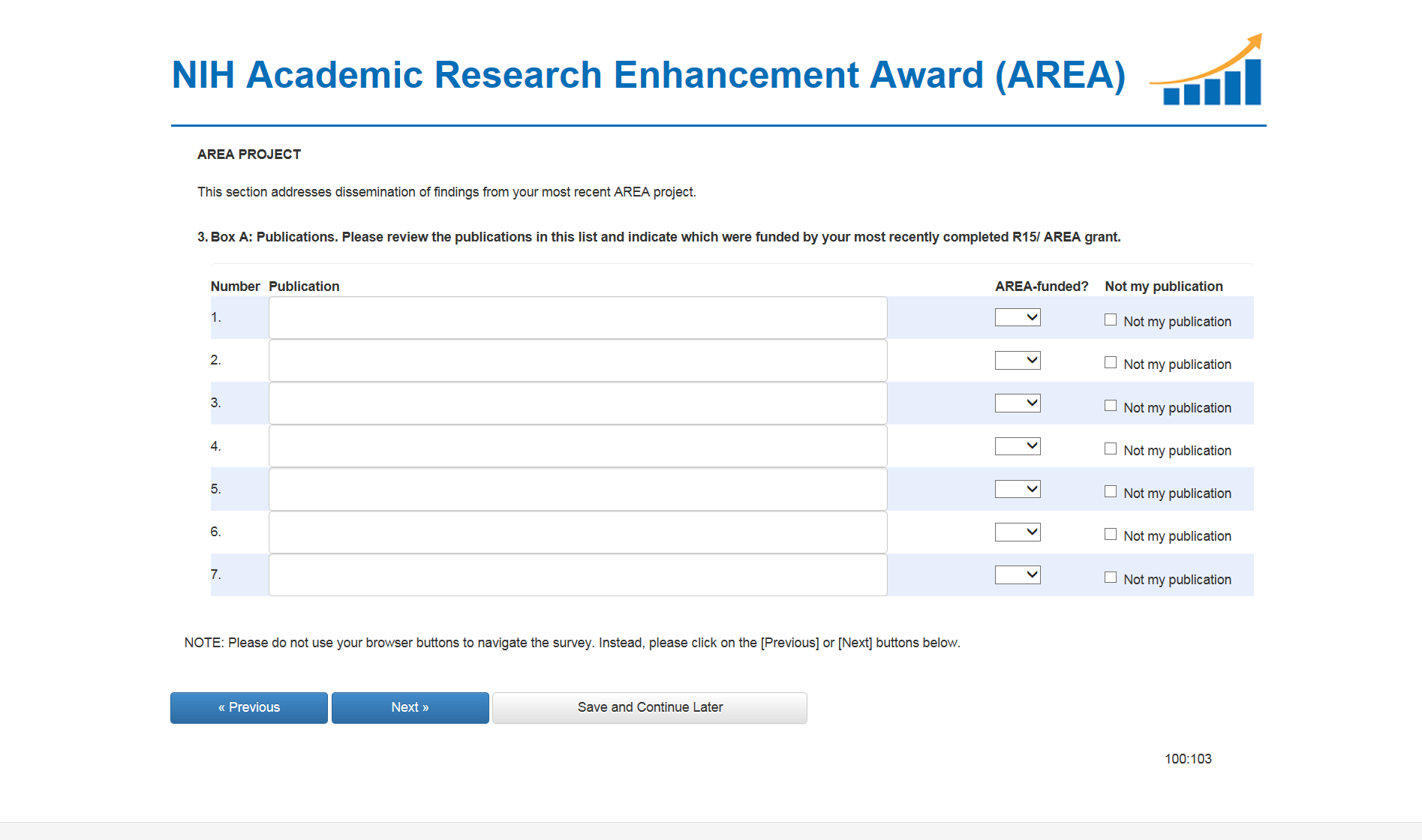
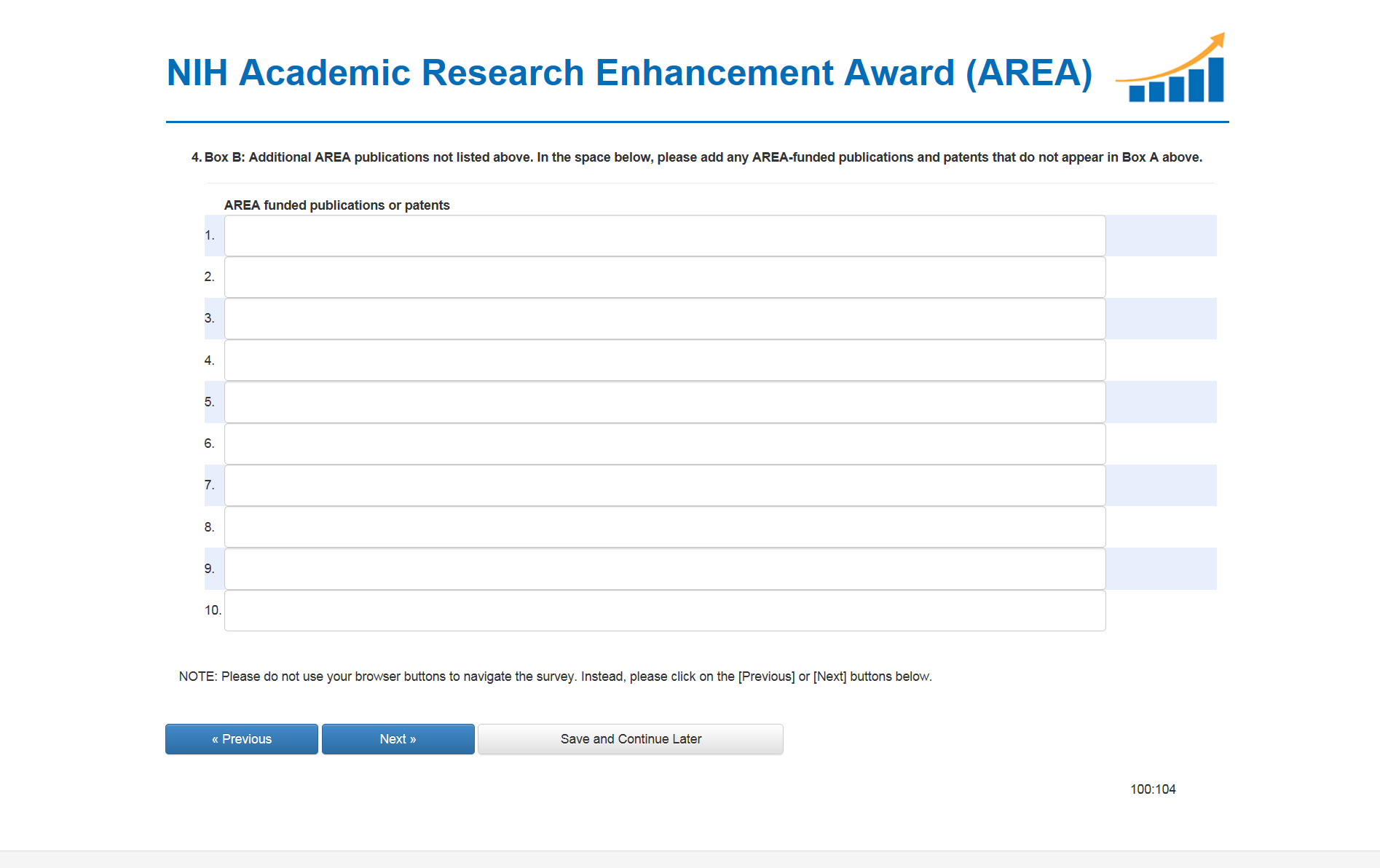
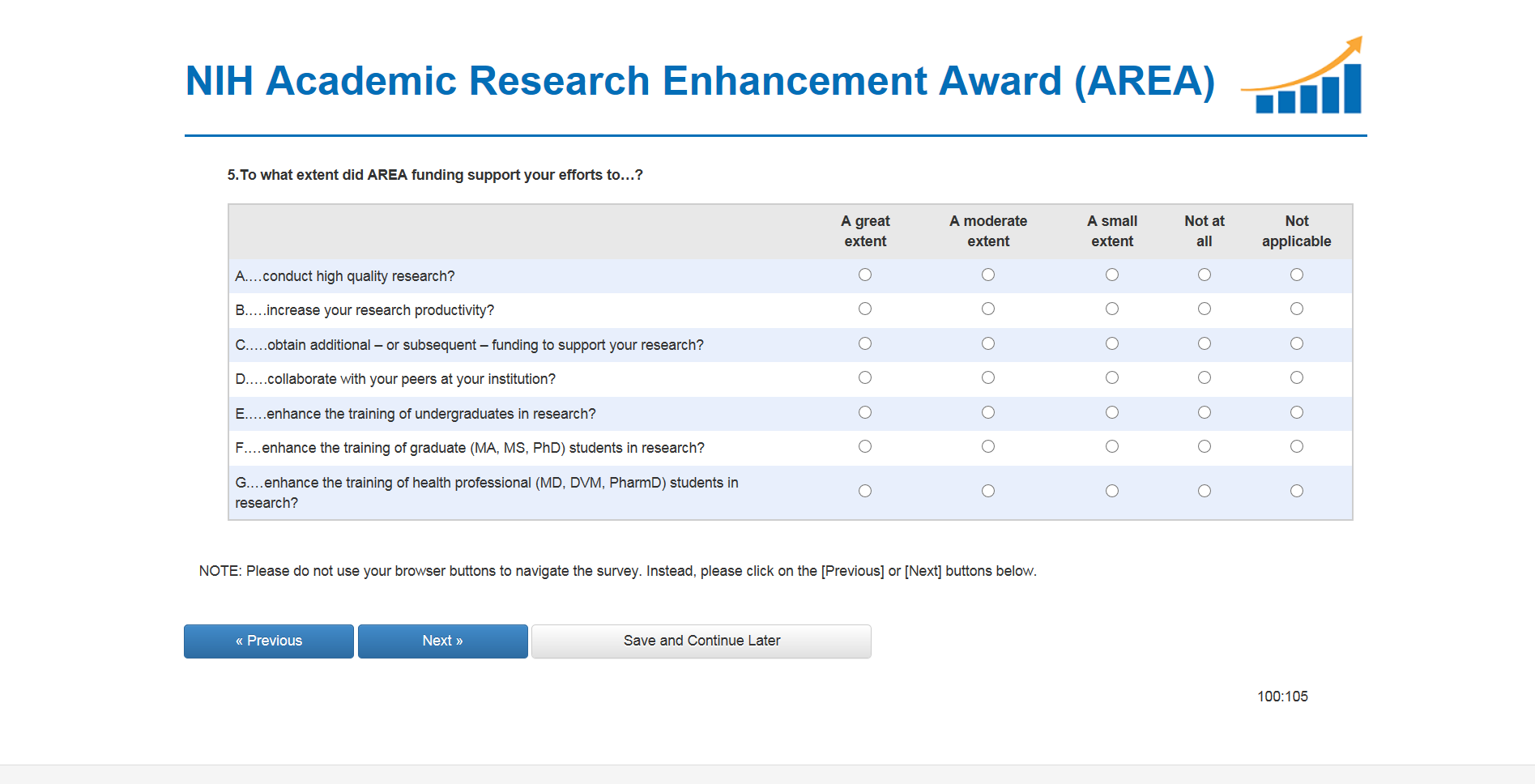
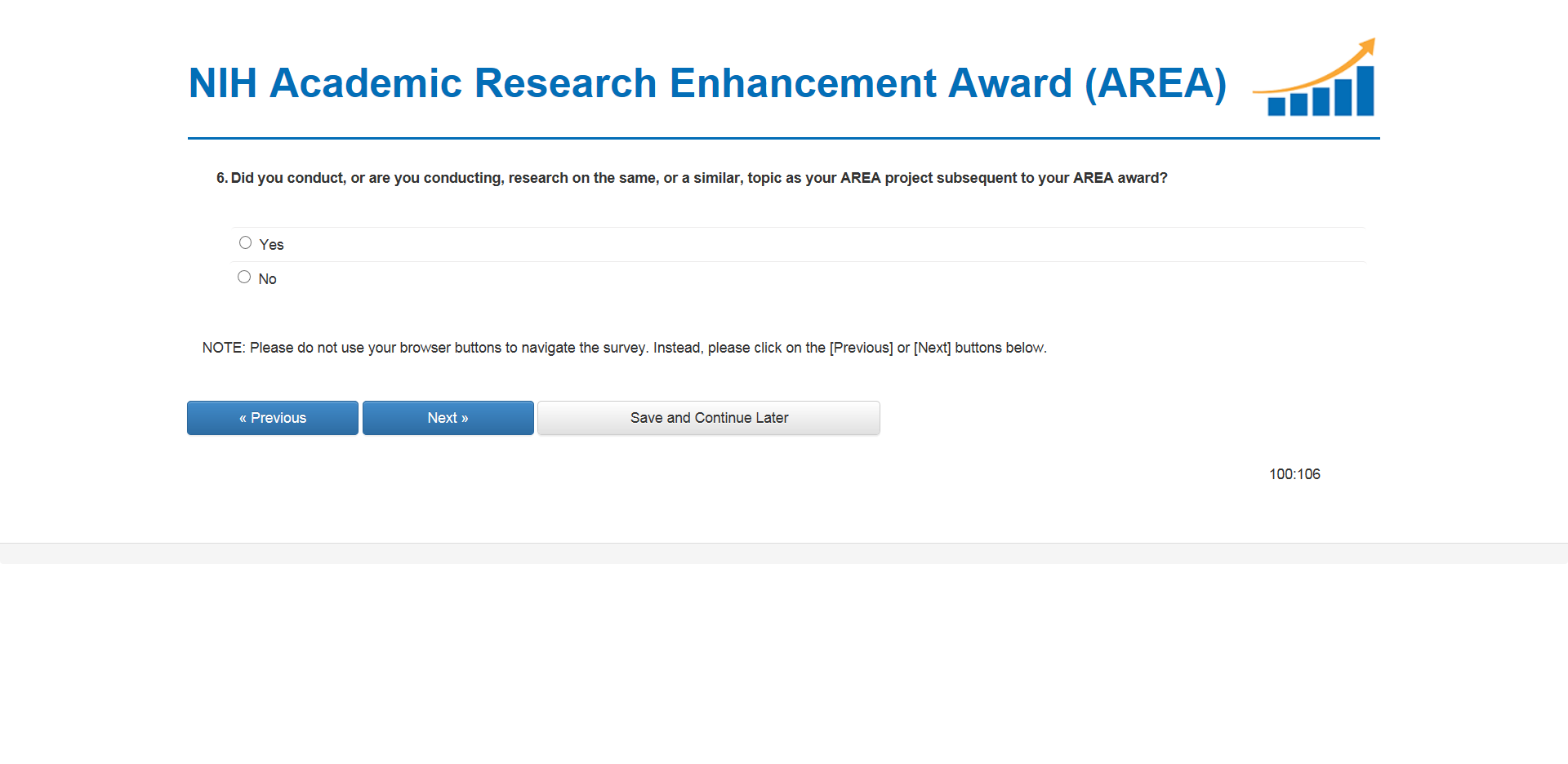
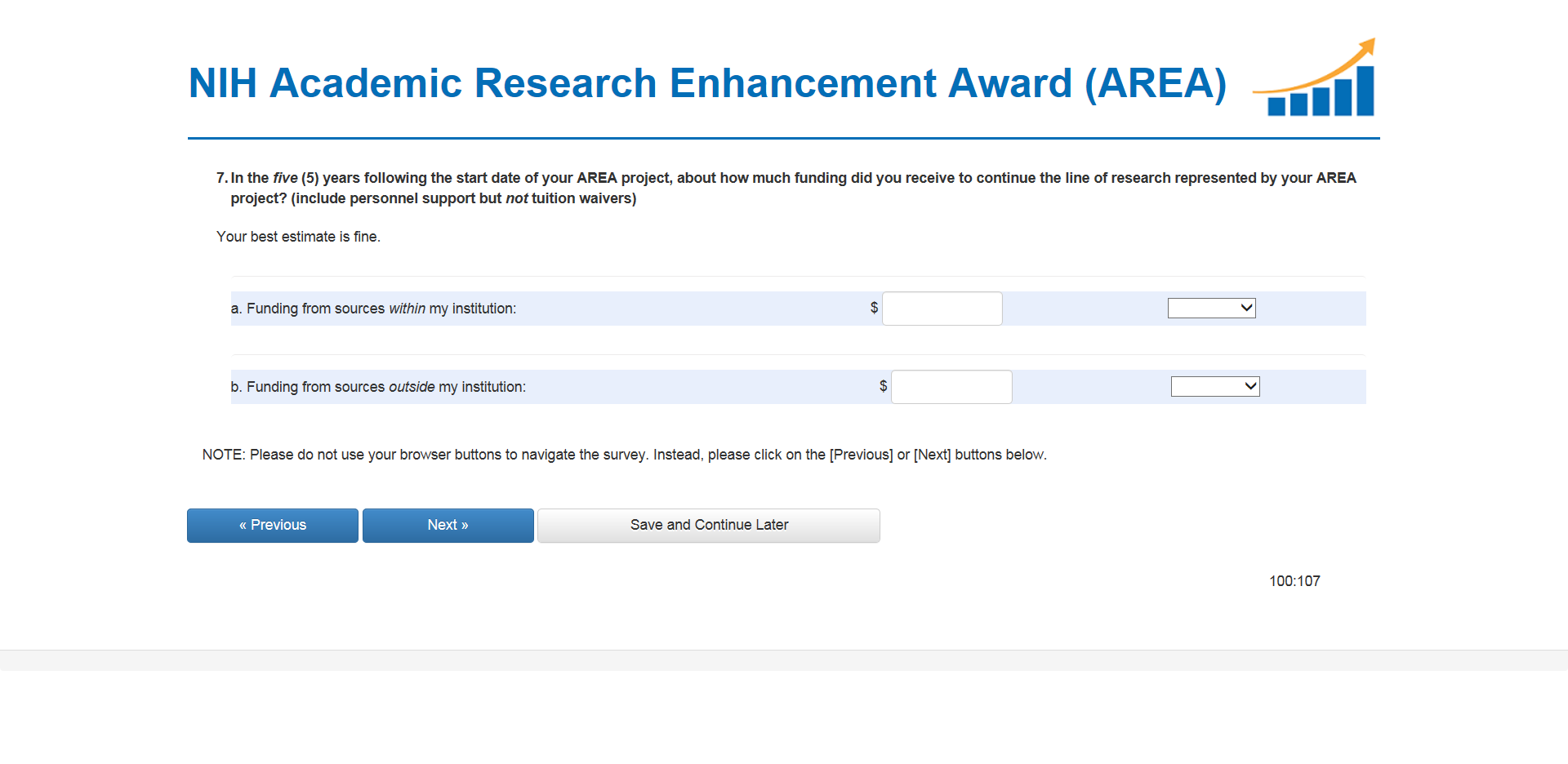




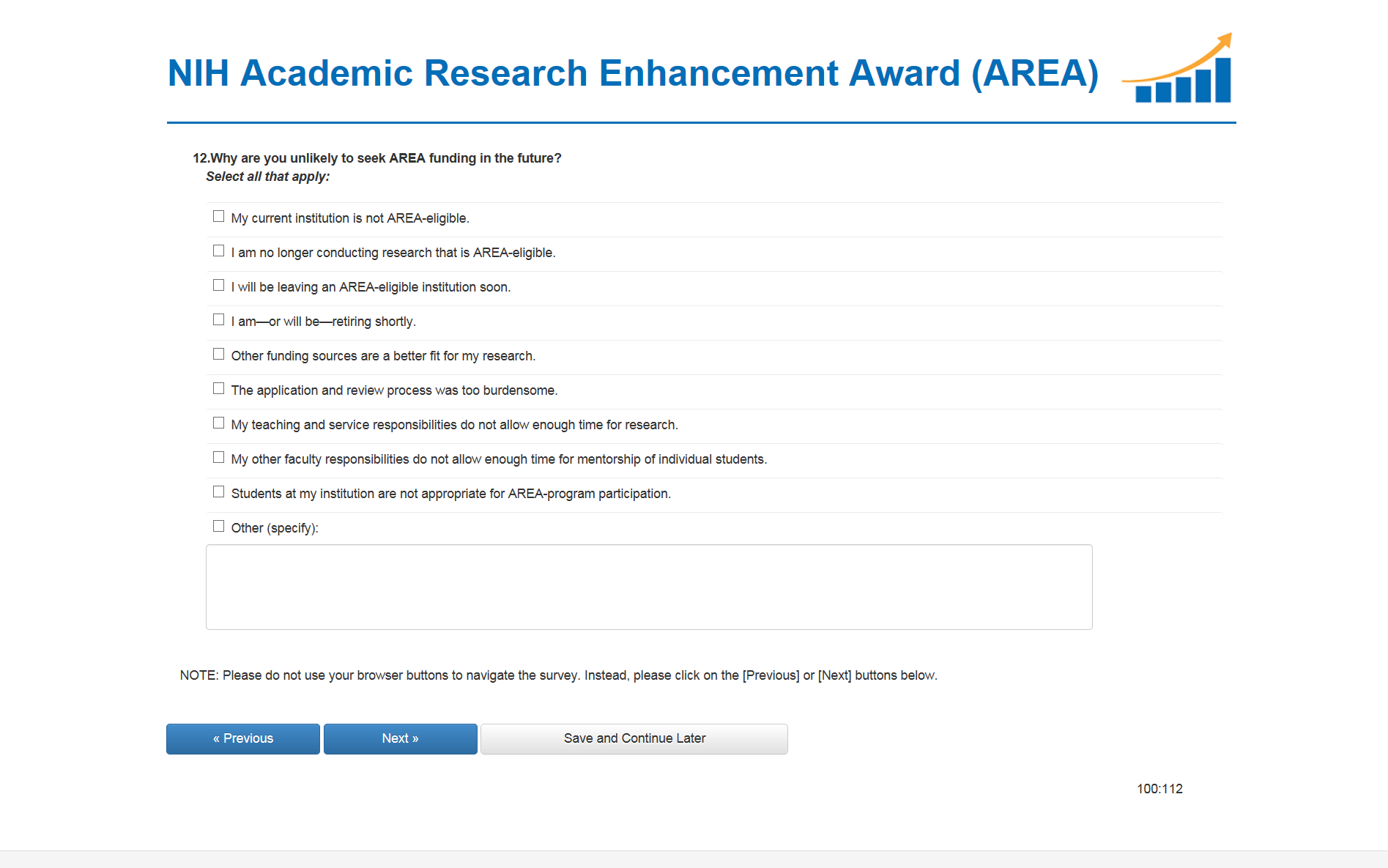




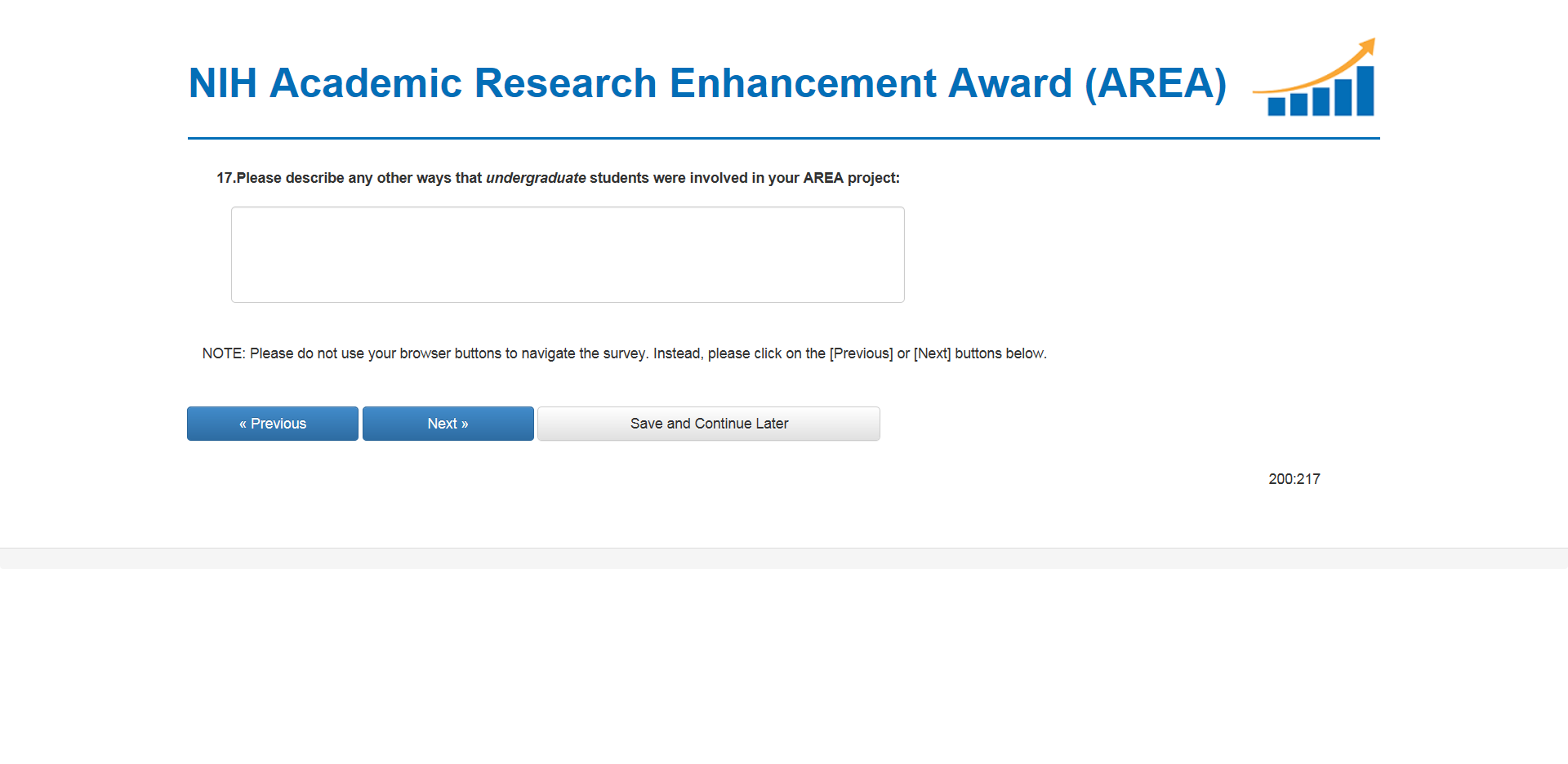
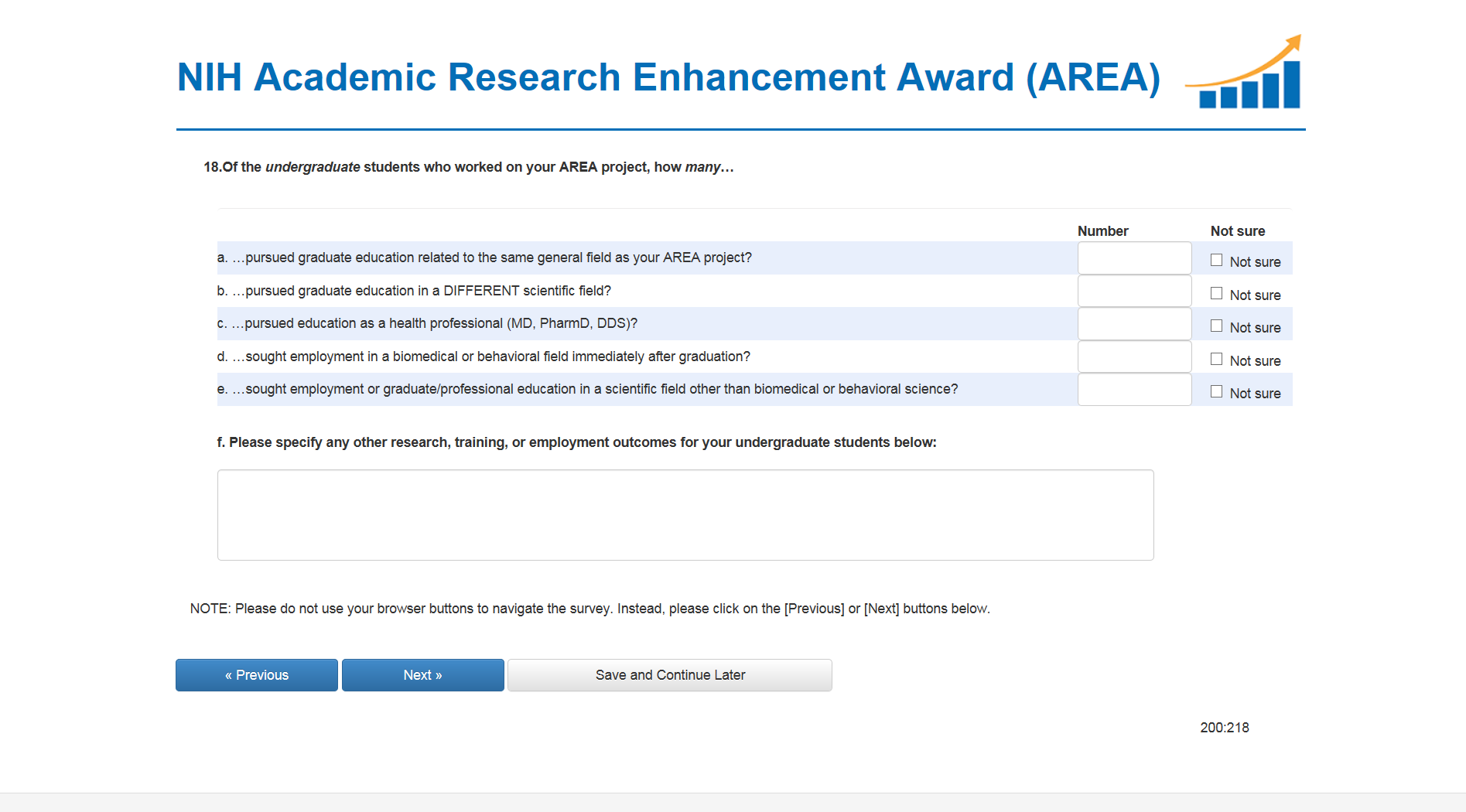














| File Type | application/vnd.openxmlformats-officedocument.wordprocessingml.document |
| File Title | Attachment 1 |
| Subject | Awardee Survey with Web Screenshots |
| File Modified | 0000-00-00 |
| File Created | 2021-01-26 |
© 2025 OMB.report | Privacy Policy
